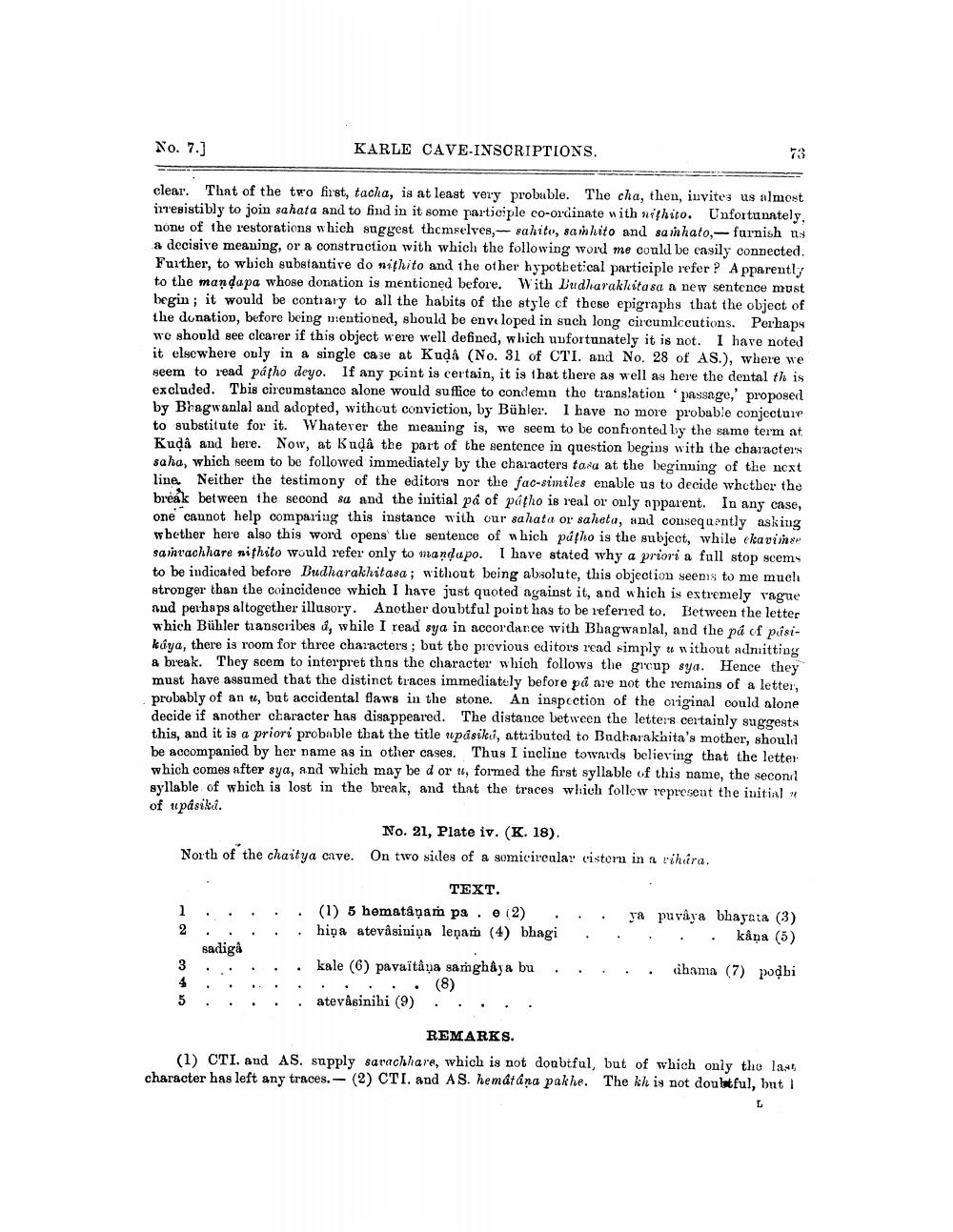________________
No. 7.]
clear. That of the two first, tacha, is at least very probable. The cha, then, invites us almost irresistibly to join sahata and to find in it some participle co-ordinate with nifhito. Unfortunately, none of the restorations which suggest themselves,- sahite, samhito and samhato,- furnish us a decisive meaning, or a construction with which the following word me could be easily connected. Further, to which substantive do nithito and the other hypothetical participle refer? Apparently to the mandapa whose donation is mentioned before. With Dudharakkita sa a new sentence must begin; it would be contrary to all the habits of the style of these epigraphs that the object of the donation, before being mentioned, should be enveloped in such long circumlccutions. Perhaps we should see clearer if this object were well defined, which unfortunately it is not. I have noted it elsewhere only in a single case at Kuda (No. 31 of CTI. and No. 28 of AS.), where we seem to read pátho deyo. If any point is certain, it is that there as well as here the dental th is excluded. This circumstance alone would suffice to condemn the translation passage,' proposed by Bhagwanlal and adopted, without conviction, by Bühler. I have no more probable conjecture to substitute for it. Whatever the meaning is, we seem to be confronted by the same term at Kuda and here. Now, at Kudâ the part of the sentence in question begins with the characters saha, which seem to be followed immediately by the characters tasa at the beginning of the next line. Neither the testimony of the editors nor the fac-similes enable us to decide whether the break between the second sa and the initial på of patho is real or only apparent. In any case, one cannot help comparing this instance with our sahata or saheta, and consequently asking whether here also this word opens the sentence of which patho is the subject, while ekavinse samvachhare nithito would refer only to mandapo. I have stated why a priori a full stop scems to be indicated before Budharakhitasa; without being absolute, this objection seems to me much stronger than the coincidence which I have just quoted against it, and which is extremely vague and perhaps altogether illusory. Another doubtful point has to be referred to. Between the letter which Bühler transcribes &, while I read sya in accordance with Bhagwanlal, and the på of pásikaya, there is room for three characters; but the previous editors read simply u without admitting a break. They seem to interpret thus the character which follows the group sya. Hence they must have assumed that the distinct traces immediately before på are not the remains of a letter, probably of an u, but accidental flaws in the stone. An inspection of the original could alone decide if another character has disappeared. The distance between the letters certainly suggests this, and it is a priori probable that the title upasik, attributed to Budharakhita's mother, should be accompanied by her name as in other cases. Thus I incline towards believing that the letter which comes after sya, and which may be d or u, formed the first syllable of this name, the second syllable of which is lost in the break, and that the traces which follow represent the initial" of upásiki.
No. 21, Plate iv. (K. 18).
North of the chaitya cave. On two sides of a somicircular cistern in a vihara.
1
2
3
4
5
KARLE CAVE-INSCRIPTIONS.
sadigâ
TEXT. (1) 5 hematâņam pa e (2)
hipa atevâsinipa lepam (4) bhagi
kale (6) pavaïtâna samghaya bu (8) atevâsinihi (9)
73
ya puvaya bhayata (3)
kâna (5) dhama (7) podhi
REMARKS.
(1) CTI. and AS. supply savachhare, which is not doubtful, but of which only the last character has left any traces.- (2) CTI. and AS. hemåtána pakhe. The kh is not doubtful, but i
L




